
-
 Afrikaans
Afrikaans -
 Albanian
Albanian -
 Amharic
Amharic -
 Arabic
Arabic -
 Armenian
Armenian -
 Azerbaijani
Azerbaijani -
 Basque
Basque -
 Belarusian
Belarusian -
 Bengali
Bengali -
 Bosnian
Bosnian -
 Bulgarian
Bulgarian -
 Catalan
Catalan -
 Cebuano
Cebuano -
 Corsican
Corsican -
 Croatian
Croatian -
 Czech
Czech -
 Danish
Danish -
 Dutch
Dutch -
 English
English -
 Esperanto
Esperanto -
 Estonian
Estonian -
 Finnish
Finnish -
 French
French -
 Frisian
Frisian -
 Galician
Galician -
 Georgian
Georgian -
 German
German -
 Greek
Greek -
 Gujarati
Gujarati -
 Haitian Creole
Haitian Creole -
 hausa
hausa -
 hawaiian
hawaiian -
 Hebrew
Hebrew -
 Hindi
Hindi -
 Miao
Miao -
 Hungarian
Hungarian -
 Icelandic
Icelandic -
 igbo
igbo -
 Indonesian
Indonesian -
 irish
irish -
 Italian
Italian -
 Japanese
Japanese -
 Javanese
Javanese -
 Kannada
Kannada -
 kazakh
kazakh -
 Khmer
Khmer -
 Rwandese
Rwandese -
 Korean
Korean -
 Kurdish
Kurdish -
 Kyrgyz
Kyrgyz -
 Lao
Lao -
 Latin
Latin -
 Latvian
Latvian -
 Lithuanian
Lithuanian -
 Luxembourgish
Luxembourgish -
 Macedonian
Macedonian -
 Malgashi
Malgashi -
 Malay
Malay -
 Malayalam
Malayalam -
 Maltese
Maltese -
 Maori
Maori -
 Marathi
Marathi -
 Mongolian
Mongolian -
 Myanmar
Myanmar -
 Nepali
Nepali -
 Norwegian
Norwegian -
 Norwegian
Norwegian -
 Occitan
Occitan -
 Pashto
Pashto -
 Persian
Persian -
 Polish
Polish -
 Portuguese
Portuguese -
 Punjabi
Punjabi -
 Romanian
Romanian -
 Russian
Russian -
 Samoan
Samoan -
 Scottish Gaelic
Scottish Gaelic -
 Serbian
Serbian -
 Sesotho
Sesotho -
 Shona
Shona -
 Sindhi
Sindhi -
 Sinhala
Sinhala -
 Slovak
Slovak -
 Slovenian
Slovenian -
 Somali
Somali -
 Spanish
Spanish -
 Sundanese
Sundanese -
 Swahili
Swahili -
 Swedish
Swedish -
 Tagalog
Tagalog -
 Tajik
Tajik -
 Tamil
Tamil -
 Tatar
Tatar -
 Telugu
Telugu -
 Thai
Thai -
 Turkish
Turkish -
 Turkmen
Turkmen -
 Ukrainian
Ukrainian -
 Urdu
Urdu -
 Uighur
Uighur -
 Uzbek
Uzbek -
 Vietnamese
Vietnamese -
 Welsh
Welsh -
 Bantu
Bantu -
 Yiddish
Yiddish -
 Yoruba
Yoruba -
 Zulu
Zulu
disc brake vs drum brake scooter
Disc Brake vs. Drum Brake for Scooters An In-Depth Comparison
When it comes to scooter safety and performance, one of the most crucial components is the braking system. Two common types of brakes used in scooters are disc brakes and drum brakes. Each type has its own advantages and disadvantages, and understanding these can help you make an informed decision when it comes to purchasing or upgrading your scooter.
Disc Brakes A Modern Approach
Disc brakes are becoming increasingly popular among scooter manufacturers due to their efficient performance and modern design. They consist of a circular disc or rotor that is attached to the wheel. When the brake lever is pulled, brake pads clamp down on the rotor, creating friction that slows the scooter down.
One major advantage of disc brakes is their superior heat dissipation. When brakes are used frequently, such as during heavy braking situations, they can heat up significantly. Disc brakes tend to cool down faster than drum brakes, thereby reducing the risk of brake fade—a condition where brakes lose effectiveness due to overheating. This makes disc brakes particularly advantageous for high-performance scooters or those used in urban settings where quick stops are frequent.
Disc brakes also provide better stopping power and greater control. They are less likely to lock up under sudden braking conditions, allowing for improved handling and stability. Additionally, many modern scooters now come equipped with anti-lock braking systems (ABS) that further enhance safety by preventing wheel lock-up during emergency stops.
Drum Brakes The Traditional Choice
disc brake vs drum brake scooter

On the other hand, drum brakes have been around for a longer time and are still used in various scooters, especially those designed for budget-conscious consumers. Drum brakes consist of a cylindrical drum that rotates with the wheel, with brake shoes that press against the inside of the drum to create friction.
One of the primary advantages of drum brakes is their cost-effectiveness. They are generally less expensive to manufacture and can be easier to maintain. For beginners or those who use their scooters primarily for short trips, the simpler mechanism of drum brakes can be adequate for their needs.
However, drum brakes do have some limitations. They are more prone to overheating, especially under continuous heavy use. This can lead to brake fade, making them less reliable for aggressive riding or high-speed situations. The enclosed design of drum brakes can also make maintenance slightly more challenging, as dirt and debris can accumulate inside the drum, affecting performance over time.
Making the Right Choice
Choosing between disc and drum brakes largely depends on how you plan to use your scooter. If you are someone who frequently rides in urban settings, tackles steep hills, or enjoys higher speeds, disc brakes may be the better option for you due to their superior performance, heat dissipation, and advanced safety features. On the other hand, if you primarily use your scooter for leisurely rides or short commutes, drum brakes can still provide adequate stopping power at a more affordable price.
In conclusion, both disc brakes and drum brakes have their own unique sets of benefits and drawbacks. Understanding these differences can greatly assist you in selecting the right braking system for your scooter, ensuring you enjoy a safe and pleasant riding experience. Whether you go for the modernity of disc brakes or the simplicity of drum brakes, the key is to choose what aligns best with your riding needs and preferences.
-
What Are Drum BrakesNewsJul.07,2025
-
Understanding Brake Drum MaterialNewsJul.07,2025
-
Semi-Trailer Brake Drum: A Key Component for Extreme Loads and Long-Distance TransportNewsJul.07,2025
-
Drum Brake Pads for SaleNewsJul.07,2025
-
Brake Drums for SaleNewsJul.07,2025
-
Brake Drum ManufacturerNewsJul.07,2025
-
Aluminum Brake Drums: The Future of High-Performance CarsNewsJul.07,2025
